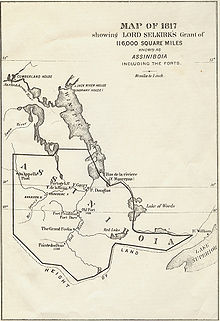
In January 1814, Governor Miles MacDonell, appointed by Thomas Douglas, 5th Earl of Selkirk issued to the inhabitants of the Red River area a proclamation which became known as the Pemmican Proclamation.[1] The proclamation was issued in attempt to stop the Métis people from exporting pemmican out of the Red River district. Cuthbert Grant, leader of the Métis, disregarded MacDonell's proclamation and continued the exportation of pemmican to the North West Company.[2] The proclamation overall, became one of many areas of conflict between the Métis and the Red River settlers.[2] Thomas Douglas, 5th Earl of Selkirk had sought interest in the Red River District, with the help of the Hudson's Bay Company as early as 1807. However, it was not until 1810 that the Hudson's Bay Company asked Lord Selkirk for his plans on settling in the interior of Canada.[1]
The Red River Colony or the Selkirk Settlement included portions of present-day southern Manitoba, northern Minnesota and eastern North Dakota, in addition to small parts of eastern Saskatchewan, northwestern Ontario and northeastern South Dakota.[3]
- ^ a b Carter, George E (1968). "Lord Selkirk and the Red River Colony". The Magazine of Western History. 18 (1): 60–69. JSTOR 4517222.
- ^ a b "The Metis and the Red River Settlement." Canada's First Peoples. 2007. Accessed February 9, 2015.
- ^ "The Canadian Encyclopedia". Archived from the original on 2006-09-05. Retrieved 2014-02-04.